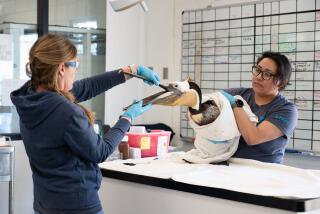Avian Surgery Depends on Much More Than a Wing and a Prayer
- Share via
Tarzana veterinarian Atilla Molnar has done some unusual operations in his day. He’s performed uterus-saving surgery on a roseate spoonbill, and he’s castrated rattlesnakes. But the night before he operated on Liberty, he was too excited to sleep.
Liberty is a 5-year-old female bald eagle and this week Molnar had to amputate the injured bird’s right wing.
“It’s a once-in-a-lifetime thing to touch a bird like this. This was like driving a Lamborghini, as compared to a Honda Civic,” said Molnar, 38, who sees many more pet parrots in his practice than birds of prey.
His partner at Capri Plaza Pet Clinic, 32-year-old Kerry Milliken, is also the attending veterinarian at the Santa Barbara Zoo, where Liberty lives with another bald eagle, named Betsy.
One recent morning, when their keeper checked on the majestic birds, she discovered that Liberty had broken her wing so badly that the bone was poking through the skin.
It wasn’t clear how the eagle had been hurt. But its wing had been injured before, and the new compound fracture left it vulnerable to a life-threatening infection.
Milliken, who assisted in the operation, said she had wanted Liberty to be treated by Molnar because he is skilled in avian surgery and after-care.
“Birds are so fragile, unlike dogs and cats,” said Molnar, who has operated on a red-tailed hawk, but never before on a bald eagle.
Anesthetizing one of these imposing raptors is tricky. They are more prone than other birds to developing heart arrhythmias during surgery. “And they cool very fast,” Molnar said.
To compensate for that, the surgical table was warmed and the operating room was heated to 86 degrees--uncomfortably warm for humans wearing surgical masks and gowns.
Eagles have high blood pressure, Molnar said: “If you hit a big vessel, they can bleed out in minutes.”
Carefully controlling fluids during the two-hour operation is also essential, they said. The bird needs enough to ensure that its air sacs remain moist and efficient but not so much that excess fluid spills into its lungs.
Liberty couldn’t fly before the amputation. Part of her right wing had been removed after an earlier injury.
“Since it only had one functional wing to begin with, it’s not a major change for this bird. Now she can go back to her exhibit, and we don’t have to worry about her falling on a stump,” Milliken said.
Before the operation, Molnar consulted Patrick Redig, director of the Raptor Center at the University of Minnesota--the equivalent of the Mayo Clinic, for ailing eagles.
Redig and his colleagues treat nearly 120 eagles annually, most of them bald eagles, as well as 800 other raptors and some trumpeter swans.
What the vet must do, Redig explained, was meticulously suture the muscles over the top of the shoulder to form a padded envelope.
That’s exactly what Molnar did. “This bird is going to fall down in the future for certain,” he said, “but at least it’s going to land on something soft.”
In some ways, large birds are easier to operate on than small ones, because the latter have tiny bones and blood vessels, Redig said.
But bald eagles are never easy to deal with.
The bald eagle didn’t become the symbol of a rebellious young nation by being a pussy cat. They are incredibly strong.
Only a pre-teen, Liberty stands 2 1/2-feet tall, weighs a muscular 3.8 kilograms (about eight pounds), and is equipped with formidable talons and three inches of curved beak.
Bald eagles are like “coiled springs,” Redig said. “They’re very fractious. Without much provocation, they’ll start flailing around inside their cages.”
The Raptor Center pads the walls and ceilings of the rooms where it keeps bald eagles, he said.
Two days after surgery, Liberty was well on her way to recovery. Her sutures won’t come out for 10 to 14 days, but she had already polished off a rat and was working on a large trout. “She’s a gorgeous bird,” said Molnar, his voice full of respect for his magnificent convalescent.
More to Read
Sign up for Essential California
The most important California stories and recommendations in your inbox every morning.
You may occasionally receive promotional content from the Los Angeles Times.













